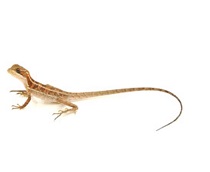Brown Basilisk (Basiliscus vittatus)
Description: The male brown basilisk can reach 61 centimetres (24 in) in total length (including tail), but the female is somewhat smaller. It has a three-part dorsal crest on the head, along the back, and along the tail. Coloration is brown or olive brown with black crossbands. The crossbands are usually only on the flanks and on the dorsal crest. There is also a white stripe, which extends from the eyes to the rear legs. The male has a larger crest than the female. The brown basilisk weighs 0.44–1.32 lb. It has long toes with sharp claws. Because of this lizards ability to run across water in short distances, in certain circles it has been christened the "lagartija de Jesu Cristo," Jesus Christ lizard
Habitat: This species can be found in tropical and subtropical wet, moist, and dry forests. It occurs in dense vegetation along the margin of practically any body of water.
Range: Basiliscus vittatus is native to Latin America. It is found from Central Mexico southward to northern Colombia. Just recently it has been introduced to Florida. In Guatemala, this species is widespread, found practically anywhere where there is a water source. Introduced into Florida and Louisiana.
Found in these States:
FL |
LA
Diet: Striped basilisks feed mostly on insects but are reported to sometimes feed on fallen berries.
Reproduction: Sexual maturity is reached at about 9 to 10 cm. at less than a year of age, and during the wet season it has been estimated that hatchlings may reach sexual maturity in as little as three months (Campbell 1998). Females lay 3 to 12 eggs from May to August in a secluded moisture retaining nesting site, usually a hole along a canal bank. The young hatch during the early part of the rainy season from June to September in about 55 to 65 days. Females choose a safe nest site for their eggs. After laying the eggs there is no further parental care.
Status: Listed as Least Concern because it is very widespread, common, and very adaptable to habitat alteration, and its population is stable.
Subspecies: None in our region.
»» Kingdom: Animalia - Animals
»» Phylum: Chordata - Chordates
»» Subphylum: Vertebrata - Vertebrates
»» Class: Reptilia - Reptiles
»» Order: Squamata - Lizards
»» Family: Corytophanidae - Helmeted Lizards
»» Genus: Basiliscus
»» Species: Basiliscus vittatus - Brown Basilisk
»» Subspecies: None
This article uses material from the Wikipedia article "Brown Basilisk", which is released under the Creative Commons Attribution-Share-Alike License 3.0. Content may have been omitted from the original, but no content has been changed or extended.
|







